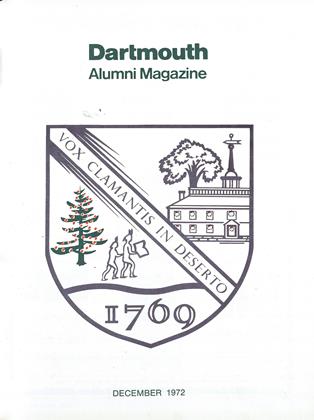THE THREAD OF ARIADNE: THE LABRYINTH OF THE CALENDAR OF MINOS.
DECEMBER 1972 JOHN B. STEARNS '16By Charles F. Herberger '42.New York: Philosophical Library, Inc.,1972. 158 pp. $l2.
Professor Herberger, like Theseus, has followed the gossamery thread of Ariadne through the Labyrinth of Minoan civilization and, I am convinced, slain the Minotaur, this time for good. Ariadne, he believes, was a Cretan moon-goddess of life in death and death in life, the spouse of the sun-god, also his mother, his sister and his slayer. Their cult resembles that of Ishtar and Tammuz, Isis and Osiris, Venus and Adonis. Careful examination of sculptures, frescoes, inscriptions, gems, seals and the tablets in Linear B script at Herakleion, Knossos, Phaistos, Stonehenge, the Ashmolean Museum at Oxford and elsewhere indicates that the Minoan religion was based upon recurrent festivals symbolic of the mystic marriage of the sun and moon from which the Olympic games were derived.
The Labyrinth thus becomes a symbol of the underworld and the Pillars of Herakles are no longer Gibralter but the gate to the afterlife. The Minotaur with the head of a bull and the body of a man is a transitional stage from the theriomorphic symbolism of the Bronze Age to the anthropomorphism which has dominated Western thought ever since.
Professor Herberger believes that the Minoans emphasized synthetic rather than analytic methods and cautions us against assuming that they were trying their best to think like us but made a mess of it. Myth is one form of synthesis, and it is from this "swan's egg of Leda" that the creative energies of Western Civilization were born. Daidalos the creator of the Labyrinth was both scientist and poet, master of mathematics and music, religion and athletics, dancing and drama because he was at home in the realm of mythopoeic thought. Icarus the eager but naive son of Daidalos flew so near the sun that he melted the scientific wax from his wings and ended in the abyss of analytic logic. Professor Herberger poses a pungent question: "Is mythopoeic thought lost to man, superseded by the mechanistic logic of the computer?" His answer is optimistic: "I think not-or not for long. The substance of thought is forever in flux, but the forms remain the same." This seems to me both true and important.
The primary purpose of this book is closely reasoned scholarship, but it seems, to be written with the humble hope that the general reader will understand and enjoy it. The author is well aware that Crete in the Spring is beautiful with pink almond blossoms, red and white anemones, asphodel and golden oxalis and that in the autumn we can still watch, as Homer did, the setting of the Pleiades and the noisy flight of the migrating cranes. Come to think of it, Homer had a pretty fair grasp of synthetic thought. "Crete," he says, "is fair and fertile. Therein are many men and ninety cities. There too is Knossos, a great city, where Minos was king, a friend of almighty Zeus." Right on, Homer.
Mr. Stearns is Daniel Webster Professor andProfessor of the Latin Language and Literature, Emeritus, Dartmouth College...
 View Full Issue
View Full Issue
More From This Issue
-
 Feature
FeatureThe U.S.-Canadian Relationship
December 1972 By JOHN SLOAN DICKEY '29 -
 Feature
FeatureEgyptologist
December 1972 By MARY ROSS -
 Feature
FeatureHall of Hallmark
December 1972 -
 Feature
FeatureClub Officers Hold Annual Meeting
December 1972 -
 Feature
FeatureRugby Posts A Winning Fall Season
December 1972 By TREVOR O'NEILL '73 -
 Article
ArticleFaculty
December 1972 By ROBERT B. GRAHAM '40
JOHN B. STEARNS '16
-
 Article
ArticleA Reply to Commencement Critics
June 1938 By JOHN B. STEARNS '16 -
 Article
ArticleGEORGE DANA LORD
August 1945 By JOHN B. STEARNS '16 -
 Books
BooksALL THE BEST IN THE MEDITERRANEAN
March 1952 By John B. Stearns '16 -
 Books
BooksEURIPIDES II.
July 1956 By JOHN B. STEARNS '16 -
 Feature
FeatureA Teaching Boon
MAY 1957 By JOHN B. STEARNS '16 -
 Books
BooksHESIOD: THE WORKS AND DAYS, THE-OGONY, THE SHIELD OF HERAKLES.
January 1960 By JOHN B. STEARNS '16
Books
-
 Books
BooksYARDSTICKS FOR INDUSTRIAL RESEARCH.
April 1960 -
 Books
BooksShelflife
Nov/Dec 2005 -
 Books
BooksSCIENTISTS IN ORGANIZATIONS: PRODUCTIVE CLIMATES FOR RESEARCH AND DEVELOPMENT.
JANUARY 1968 By JOHN T. LANZETTA -
 Books
BooksInfested With Sharks
June 1980 By Joseph W. Bishop Jr. ’36 -
 Books
BooksTHE ROMANESQUE LYRIC
APRIL 1930 By Lawrence Leighton -
 Books
BooksWhat If?
June 1981 By R. H. R.

